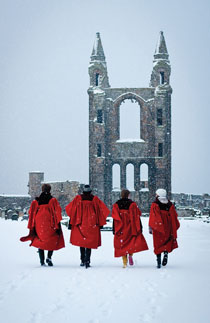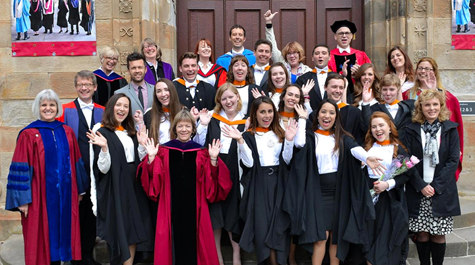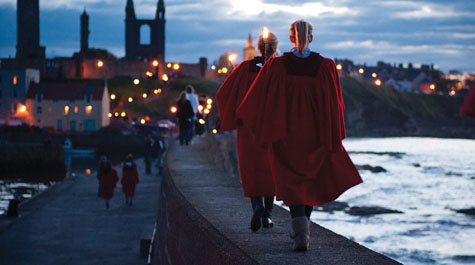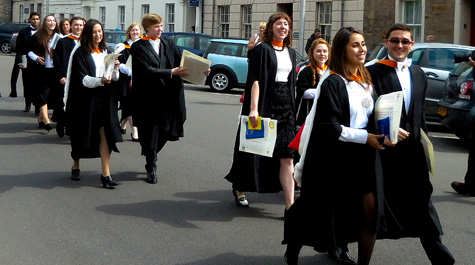William & Mary & Andrew
The first cohort of students in the St Andrews William & Mary Joint Degree Programme graduated in May and June ceremonies at both universities. The 22 students received one degree, conferred by both William & Mary and St Andrews. The following story originally appeared in the spring 2015 issue of the W&M Alumni Magazine. - Ed.
On a Sunday morning, students from the University of St Andrews, clad in red robes, descend from a hilltop to a small, sheltered beach known as the East Sands. Upon reaching the water, they begin a journey along the pier that juts far out into St Andrews Bay. St Andrews is so old (602 years) that the reasons for certain traditions have been lost in time. The Pier Walk is one of these.
Things are different here. According to Andrew Hashim ’15, the university is a social experiment tucked into a small town on the east coast of Scotland. “Here, in a town of only three streets, every other person (more often than not) will be from a different country,” he said. “While you’re here it seems normal. When you leave, you realize how special it really is.”
Here, you can still walk down old cobblestone streets, through crumbling archways and have a drink in a centuries-old tavern. The town has retained many of its medieval features, including the 12th-century cathedral and castle. The visible history creates a charming atmosphere within this college town, and with the St Andrews William & Mary Joint Degree Programme, students from America’s second oldest institution get to experience Scotland’s oldest — and vice versa.
The beginning
As hard as it is to uncover the mystery behind some St Andrews traditions, it is just as difficult to pinpoint the exact origins of the Joint Degree Programme. The exact year discussions started varies, depending on whom you talk to. But two men seemed to be at the heart of the discussion: Hank Wolf ’64, J.D. ’66, former rector of the College, and vice president of St Andrews Stephen Magee. Legend has it that while Wolf was staying at his flat in St Andrews, he played golf with Magee. In a Board of Visitors meeting years ago, Wolf had expressed concern that in terms of international experiences, William & Mary students were lagging behind students from other institutions. Wolfe also believed the College should be attracting more international students, much like Harvard and Georgetown were doing. Over the years, William & Mary had formed a relationship with St Andrews through study abroad programs and it seemed natural to build upon that. The two began to discuss international opportunities and thought a joint degree program would work well with William & Mary and St Andrews, given their similarities. The proposal was brought back to Professor Laurie Koloski, who served as director of the Reves Center from 2006-10. The idea was to gather 20 to 30 students from each institution and give them the opportunity to spend two years at each university.
“Joint degrees were something I’d heard about not long before, and it sounded like a great idea,” Koloski said. “Why not at least give it a try?”
Koloski drafted letters to colleagues in various departments around campus, asking if they were interested in pursuing the program. “To be honest, I didn’t expect any answers,” she said. “But faculty in history, economics and international relations applied almost immediately. So off we went.”
How hard can it be?
The faculty really grew the program. “Which is the way to do it,” said Professor Colleen Kennedy, academic director of the Joint Degree Programme. “Things that happen from the top down don’t always work that well. But they did this the right way.”
The three programs that expressed an initial interest were later joined by the English Department. These programs had to come together with their counterparts at St Andrews to work out some kind of major that reflected what both institutions would require.
“This was one of those things where you initially ask yourself: How hard can it be?” Koloski said. “And then realize quite quickly that the answer is, pretty hard, actually!”
 The drivers of the program knew they wanted to bring together the best of both universities and to offer programs that would give students the advantages of the liberal arts education William & Mary was known for, while also providing a depth of study in a single discipline that epitomized the St Andrews curriculum. It sounded great in theory — but how would administrators be able to ensure, for example, that students fulfill the breadth requirements of such a program when they’re spending two of their four years overseas? How could they ensure that students would successfully navigate the transition from sub-honours (first- and second-year) to honours (third- and fourth-year) classes at St Andrews, when they’re not there during the second year?
The drivers of the program knew they wanted to bring together the best of both universities and to offer programs that would give students the advantages of the liberal arts education William & Mary was known for, while also providing a depth of study in a single discipline that epitomized the St Andrews curriculum. It sounded great in theory — but how would administrators be able to ensure, for example, that students fulfill the breadth requirements of such a program when they’re spending two of their four years overseas? How could they ensure that students would successfully navigate the transition from sub-honours (first- and second-year) to honours (third- and fourth-year) classes at St Andrews, when they’re not there during the second year?
“And the academic challenges were just the beginning,” Koloski said. There were other issues that needed to be addressed, everything from how the students’ courses appear on transcripts to housing, visas and health care.
Even though the two institutions are very similar, getting everything to connect has been challenging. “We still do things differently, and there are things W&M just assumes and things St Andrews just assumes and because of that we don’t think to tell each other,” Kennedy said.
Kennedy heads over to St Andrews in February every year to meet with first-years. Those students have to register in March using an unfamiliar W&M online system. Kennedy takes them through the process, explains to them how Banner works, and talks to them about what they can expect at William & Mary. It’s taken time, but administrators have come to recognize the challenges and what needs to be done to work through them.
When the program started in 2011, 38 students enrolled. Four years later, that number has grown to 106. More than a study abroad program, students complete two entire years at each institution, receive two sets of transcripts from the schools, and earn a bachelor of arts (international honours) with the insignia of both institutions. Students who apply to the Joint Degree Programme through William & Mary spend their first year at W&M and their second at St Andrews. The decision on how to split the third and fourth years is made between students and their advisers.
The program joins the breadth characteristic of William & Mary’s liberal arts education with the depth of study for which St Andrews is famous, combining the best aspects of two academic traditions, while offering students a greater range of academic choices and the opportunity to acquire knowledge of two intellectual and national cultures.
Going abroad
Abby Gomulkiewicz ’15 grew up in love with William & Mary. The first time she learned about the College was in the fourth grade and visited Colonial Williamsburg. “I had a magical time there which cemented my love for history,” she said. “When I learned there was a university nearby, I knew that I wanted to go there, even though it was far away. It was always my dream school growing up.” To Gomulkiewicz, the Joint Degree Programme seemed like an unprecedented opportunity to push her as an individual and a scholar. “I had always wanted to study abroad and the program took the study abroad experience to the next level,” she said. “I saw that it would allow me to more fully engage with two cultures as well as two university environments where history was taught in different manners.”
Having never visited St Andrews, Gomul-kiewicz was nervous arriving at the school for her sophomore year. “It was like being a freshman all over again,” she said.
That sophomore year can be stressful for a lot of students. As Kennedy points out, students in the program have to spend their second year at the other school. As sophomores, they are forced to make a change, and so are first-years at two different universities two years in a row. “That second year is by far the most challenging year,” Kennedy said. “But I think it’s the one that marks them as successful in the program.”
The Joint Degree programme has created many safeguards, including academic advisers and peer mentors, which have helped ease the transition. The students who prosper in the second year, sometimes after a difficult first semester, learn a very valuable technique for adjusting and overcoming difficulties.
Although Gomulkiewicz was nervous, she looked at her sophomore year as the start of her Joint Degree adventure. At the first lunch held in the Commons, she was able to connect with a group of friends who shared her mixed emotions.
“As the first cohort, it was especially important that we supported each other as fellow Joint Programme students, affectionately known as WAMSTAs [William and Mary/St Andrews Students],” Gomulkiewicz said. “I think all of us WAMSTAs realized how important it was to support and encourage each other as we transitioned year after year.”
One of the students she met at that lunch was Andrew Hashim. The type of person who doesn’t like to be in one place for too long, Hashim was excited by the prospect of being a member of the program’s first class. The two became close friends over the years, and they ended up creating a Coat of Arms for the Joint Degree Programme, an idea that was born in Hashim’s freshman dorm room.
“For two venerable institutions with long and proud traditions, we felt that a Coat of Arms for the Joint Degree would be the perfect uniting symbol,” Hashim said. Each element of the Coat of Arms draws a link between the two universities. Eventually Gomulkiewicz and Hashim worked directly with the Scottish Heraldry Board to get official recognition and protection for the program’s Coat of Arms. William & Mary is the only university in the United States with arms sanctioned by the College of Arms based in London.
Coming to William & Mary
For Victoria Seeck, the opportunity to attend St Andrews piqued her interest because of its reputation as a very international university. Seeck was born in Brussels, holds German nationality as both her parents are from Berlin, and grew up in Belgium, China and Egypt, attending international schools.
“When I visited the website I saw that the Joint Degree Programme was an option,” said Seeck. “I thought that it would give me the opportunity both to experience college at St Andrews, as well as give me a chance to spend a longer period in the States than I would for a holiday.”
While she did have to get used to the portion sizes in America and a city that was much smaller than Beijing or Cairo, Seeck enjoyed the opportunity to experience life as a true American. “Since most people have cars at William & Mary, I was able to go outside of the Williamsburg area and visit things a tourist wouldn’t necessarily get the chance to do,” she said. “I feel that I have really gotten a chance to experience life in America as somebody that was American.”
Seeck is the international representative of the newly created Student Partnership. The Student Partnership was created by students, for students. The Partnership serves as a mentoring service for new students who may need help adjusting to life at their new university. Seeck remembers those challenges in the early stages of the program. “As a member of the inaugural class, administration-related things have been some of those challenges,” Seeck said. “We have faced a few bumps in the road that will not be there for those following in our footsteps.”
Beyond the classroom
The class structure is the biggest difference between the institutions that Seeck has noticed. At William & Mary, a student will take more classes than at St Andrews, meaning that a student will have more everyday work with a lot of supervision by professors. However, the number of classes also mean that each class at William & Mary does not go into the same depth as a St Andrews module. On the other hand, a typical assessment at St Andrews will be worth a lot more than at William & Mary and a student will be expected to do more independent study.
“I wouldn’t say one is better than the other,” Seeck said, “but it is the most striking difference between the two institutions. But the two different styles of education have also given me the breadth of the American system and the depth of the European/Scottish system, which I think will be very useful in the future.”
“I try not to play a comparison game between the two universities,” Gomulkiewicz said. “Each school has things it does better than the other. However, the program combines what is truly best about each institution and that is the beauty of it.”
But there are similarities between the schools. William & Mary has squirrels; St Andrews has Hamish McHamish, a cat that roams about town. You can follow him on Twitter. And because both institutions have a rich history, students in the Joint Degree Programme get to experience the traditions established at each.
St Andrews’ most famous tradition is the red academic gown, usually worn during special occasions like the Pier Walk. St Andrews is also home to a large number of academic families, a tradition where older students adopt first year students as “children” and can help guide them. It is a way for first-year students to meet new people, and many of the friendships that begin as part of the academic family tradition continue throughout a student’s time at the university and beyond. This “mentoring” culminates in Raisin Weekend, when children are entertained by their “parents” and are encouraged to play pranks. On Raisin Monday, the children dress in costumes, are given strange objects with a traditional Latin inscription, and are let loose in the central St Salvator’s Quadrangle for an enormous shaving foam fight.
Another famous tradition is the May Dip, where students plunge into a freezing North Sea at dawn on the first of May, which is said to promote good luck in exams.
Looking to the future
With only four majors, the Joint Degree Programme does have a limited audience. The more majors, potentially the greater interest in the program. Kennedy says there is talk of possibly adding new majors, but that it needs to be done slowly and carefully. “Growing the program is going to involve other things, too, but there is interest from a couple of majors that I think will be attractive to prospective students. I think it will be good for the program as long as the universities have everything in place that they need to support it.”
 For Kennedy, she has a whole new set of colleagues and has started to see potential research partnerships emerge. But her most memorable moments of her involvement with the Joint Degree Programme come when she sees students who have struggled during that tough second year and are now blossoming in the program. And seeing students like Seeck, Gomulkiewicz and Hashim, members of the first class, making it all the way through. Kennedy believes these students come out of the program better prepared to face challenges and have developed a global consciousness. “Although Scotland is not that different, it’s different enough and they have to learn respect for those differences.”
For Kennedy, she has a whole new set of colleagues and has started to see potential research partnerships emerge. But her most memorable moments of her involvement with the Joint Degree Programme come when she sees students who have struggled during that tough second year and are now blossoming in the program. And seeing students like Seeck, Gomulkiewicz and Hashim, members of the first class, making it all the way through. Kennedy believes these students come out of the program better prepared to face challenges and have developed a global consciousness. “Although Scotland is not that different, it’s different enough and they have to learn respect for those differences.”
“The people that you meet and the professors that you study under have a major impact on a student studying at just one of these universities,” Hashim said. “The typical Joint Programme student gets double the experience. I can say that my outlook is more international than before I entered the program.”
Hashim has been offered the opportunity to complete a law degree at the University of Cambridge. He wants to obtain his British law degree, and then return to the United States to get his American qualifications so he can practice in both the United States and the United Kingdom.
For Seeck, her most memorable moments are the excitement and suspense of leaving an institution to go to the other. “Every time I made the exchange, I knew that my friends and memories will have changed and developed while I was gone and I never knew how it would be going back.”
English has always been Seeck’s most comfortable language, which means that in the future she would consider the United States or the United Kingdom as prospective career locations. “The program has introduced me to two new countries where I could see myself living in the future,” Seeck said. “It has changed me in so many ways both academically and socially. I have learned about different cultures, as well as expanded my education at the same time. I think the most important thing I have learned will be to always challenge myself and never think I can’t do something.”
In July, Seeck will be interning with the EU Embassy in Hanoi, Vietnam, for four months. Following the internship, she hopes to either move to Taiwan for a Chinese language course or continue with other internships to figure out what she wants to pursue in her master’s.
“Through the Joint Degree Programme, I have been offered an extremely well-rounded education, as well as an international experience which provides me insight into the beauty and complexity of our globalized world,” said Gomulkiewicz. “It has also made me better at transition and adapting which will serve me well in my future. Many opportunities have been offered to me because people see such a value in this type of education that draws on what is truly best about the American and British educational systems.”
After graduation, Gomulkiewicz plans to work in a university advancement setting, followed by another joint program that combines a Ph.D. in history and a law degree. “I guess you could say that I cannot get enough of these joint degree programs,” she said.
 Skip to main content
Skip to main content




